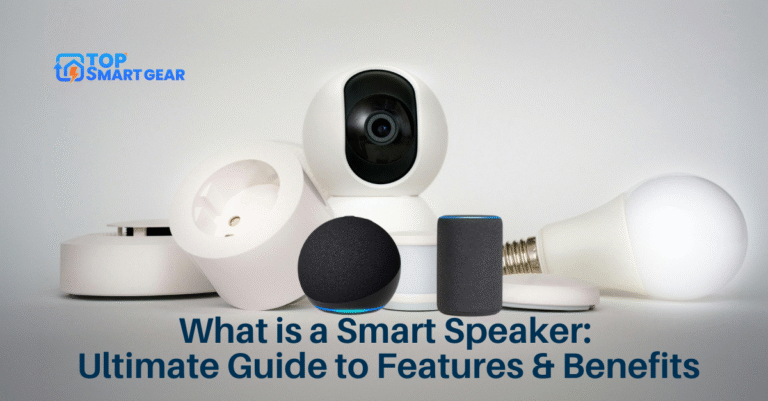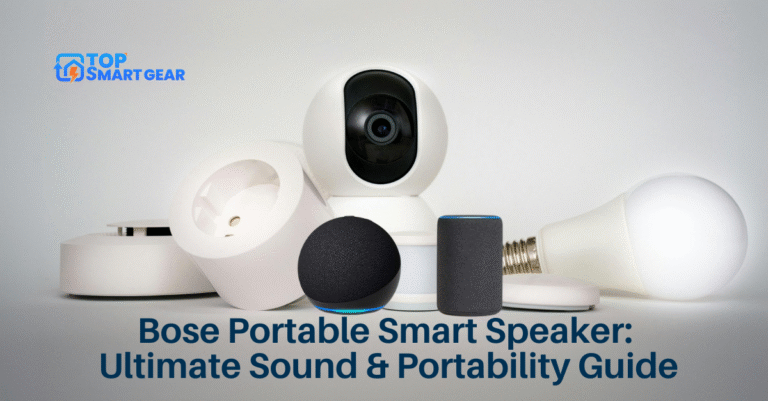Imagine having a helper in your home that listens, understands, and makes your daily tasks easier, all with just your voice. A Smart Speaker with Google Assistant can do just that.
Whether you want to play your favorite music, control your smart lights, or get answers instantly, this device is designed to make your life smoother and more connected. If you’re curious about how a smart speaker can fit into your routine and what it can really do for you, keep reading.
You might be surprised at how much easier your day can become.
Features Of Smart Speakers
Smart speakers with Google Assistant have become popular for their ease of use and helpful features. These devices bring voice control to your home, allowing hands-free access to information, music, and smart home controls. The features of smart speakers make them more than just speakers. They combine technology to offer convenience, intelligence, and quality sound in one device.

Voice Recognition
Voice control with Google Assistant is a core feature of the best Google Assistant-enabled smart speakers. It enables the device to understand and respond to your commands accurately. The AI-powered speaker with Google Assistant uses multiple microphones to hear your voice clearly, even from across the room or in noisy environments.
Key points about voice recognition:
- Far-field microphones: Capture voice from a distance.
- Noise cancellation: Filters out background sounds for better accuracy.
- Multiple user support: Recognises different voices and personalises responses.
With these features, the smart speaker can distinguish your voice from others and provide tailored answers. It can also understand natural language, making conversations feel smooth and simple. The ability to recognise commands quickly helps with tasks such as setting reminders, playing music, and controlling smart home devices.
Sound Quality
Audio performance in Google Assistant smart speakers is vital for enjoying music, podcasts, and voice responses. The best Google Nest smart speaker delivers clear, rich sound despite its compact size. Advanced Google Home speakers use technology to balance bass, mids, and treble, providing a full and immersive audio experience.
Some features that improve sound quality include:
- 360-degree sound: evenly spreads audio throughout the room.
- Adaptive sound: Adjusts volume and tone based on room size and noise.
- High-excursion drivers: Produce deep bass and clear highs.
These features help smart speakers fill any room with immersive sound. Whether you listen to music or voice answers, the sound remains crisp and natural. Many models also support stereo pairing, letting you connect two speakers for a better experience.
Connectivity Options
Connection options make the smart home speaker with built-in Google Assistant incredibly adaptable. They provide seamless pairing with multiple devices and smart ecosystems. Most voice-activated speakers feature wireless connectivity through Wi-Fi and Bluetooth support, enabling smooth access to online streaming platforms, smart TVs, and home automation systems with ease.
Common connectivity features include:
| Connection Type | Purpose | Benefits |
|---|---|---|
| Wi-Fi | Connects to the internet | Access to streaming services and smart home control |
| Bluetooth | Links to phones, tablets, or computers | Play audio from local devices |
| Auxiliary Input | Wired connection to audio devices | Stable audio without wireless interruptions |
Some smart speakers also support multi-room audio, letting you connect multiple speakers throughout your home. This creates a synchronised sound system controlled by voice or app. Easy setup and reliable connections make these speakers practical for everyday use.
Benefits Of Google Assistant
The Google Assistant-enabled smart speaker offers many benefits that make daily tasks easier and more enjoyable. Devices like the Mi smart speaker with built-in Google Assistant, JBL voice-controlled speaker with Google Assistant, and Google Nest Audio smart speaker provide hands-free assistance, smart home integration, and personalized responses. These features enhance your interaction with Google Voice Assistant technology and save time. Understanding the core benefits of smart speakers for the Google Home ecosystem shows why they’ve become so popular in modern households.
Hands-free Control
Hands-free control is one of the most valuable features of a smart speaker with Google Assistant. It lets you operate devices without touching them. Just say “Hey Google,” and the assistant listens and acts. This is very helpful when your hands are full or dirty. For example, you can:
- Play music or podcasts
- Set alarms and reminders
- Ask questions about the weather or the news
- Make phone calls or send messages
- Control other smart devices
The Mi AI-powered smart speaker with Google Assistant quickly processes voice commands, simplifying your daily routines. The JBL Google Nest-compatible speaker delivers crisp sound and enhanced voice activation performance, ensuring accurate responses even in challenging noise conditions.
| Benefit | Example |
|---|---|
| No need to use hands | Turn on lights while cooking |
| Quick access | Ask for traffic updates before leaving |
| Works in any room | Control devices from kitchen or bedroom |
Hands-free operation saves time and effort. It also assists individuals with limited mobility in managing daily activities more easily. Voice control makes smart devices like the Google Nest Audio voice-controlled speaker with Google Assistant an essential addition to any smart home.
Personalized Responses
Google Assistant gives personalised answers based on your preferences and habits. It learns your voice and offers suggestions tailored to you. This makes interactions feel natural and beneficial. For example, it can:
- Remember your favourite music and play it on request
- Suggest nearby restaurants you like
- Give calendar reminders for your appointments
- Provide weather updates for your location
- Answer questions using your search history
The Mi AI-powered smart speaker with Google Assistant learns and adapts to your daily routine over time. The JBL Google Assistant-enabled smart speaker features voice recognition technology that delivers personalized responses for each family member. The Google Nest Audio voice-controlled speaker supports multiple users while ensuring your personal data remains secure.
Personalised responses improve your experience by making information relevant and easy to understand. They reduce the need to repeat commands or correct the assistant. This saves time and avoids frustration.
Integration With Smart Home
Smart speakers with Google Assistant work well with many smart home devices. They help you control lights, thermostats, cameras, and more using voice commands. This creates a connected home that is easier to manage. Some standard integrations include:
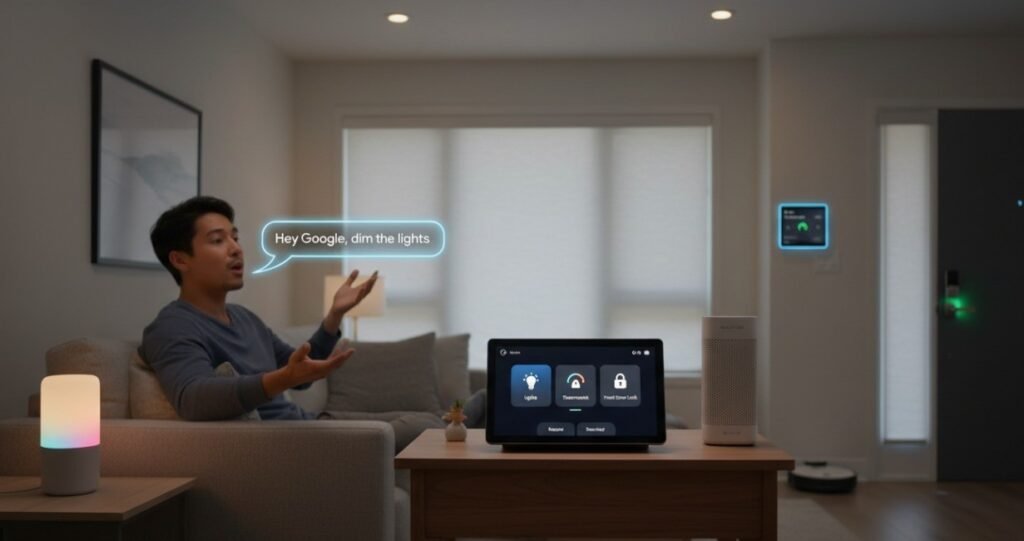
- Turning lights on or off
- Adjusting thermostat temperature
- Locking or unlocking doors
- Viewing security cameras
- Controlling smart plugs and appliances
The Mi voice-activated smart speaker with Google Assistant supports a wide range of smart home devices and brands, making home automation easy and efficient. The JBL wireless smart speaker powered by Google Assistant delivers reliable voice control and seamless connectivity for your smart home ecosystem. Meanwhile, the Google Nest Audio AI-powered smart speaker is designed to work effortlessly with Google Home-compatible smart devices, offering hands-free voice commands and high-quality sound for an enhanced smart living experience.
| Smart Device | Voice Command Example |
|---|---|
| Smart Lights | “Hey Google, dim the living room lights.” |
| Thermostat | “Hey Google, set the temperature to 72 degrees.” |
| Smart Lock | “Hey Google, lock the front door.” |
| Security Camera | “Hey Google, show me the backyard camera.” |
Integrating smart home devices with Google Assistant makes homes safer and more efficient. Voice commands reduce the need to use apps or switches. This is especially useful at night or when you are busy. Smart speakers like the Google Nest Audio smart speaker with Google Assistant become the central hub for managing your smart home.
Top Smart Speaker Models
Smart speakers with Google Assistant offer hands-free help for everyday tasks. They play music, answer questions, control smart home devices, and more. Choosing the right model depends on sound quality, size, and features. Here are some of the top smart speaker models powered by Google Assistant that fit various needs and budgets.

Google Nest Audio
The Google Nest Audio is a great choice for clear, rich sound in any room. It has a sleek design that complements modern home decor. This speaker delivers strong bass and crisp vocals, making it ideal for music lovers.
- Sound Quality: 75mm woofer and 19mm tweeter for balanced sound
- Voice Recognition: Far-field microphones hear you from across the room
- Smart Features: Control smart home devices, get news updates, and set reminders
It supports stereo pairing, so users can connect two Nest Audio speakers for a wider soundstage. The device also adapts sound based on the room’s environment, offering consistent quality.
| Feature | Description |
|---|---|
| Dimensions | 175 x 124 x 78 mm |
| Weight | 1.2 kg |
| Colors | Charcoal, Chalk, Sage, Sand, Sky |
| Connectivity | Wi-Fi, Bluetooth 5.0 |
The Nest Audio offers an excellent balance of smart features and audio quality at a reasonable price.
Google Nest Mini
The Google Nest Mini is the compact version of Google’s smart speaker lineup. It fits well in small spaces like kitchens or bedrooms. Despite its size, it produces surprisingly clear sound with improved bass compared to the original Mini.
Key features include:
- Touch controls for volume and playback
- Built-in Google Assistant to answer questions and control devices
- Wall-mountable design to save counter space
- Improved microphones for better voice detection
It connects easily to other Nest devices and supports multi-room audio, making it a flexible option. The Nest Mini is also energy efficient, using less power than larger speakers.
| Specification | Detail |
|---|---|
| Size | 98 x 42 mm |
| Weight | 181 grams |
| Colors | Chalk, Charcoal, Coral, Sky |
| Connectivity | Wi-Fi, Bluetooth |
This model suits users wanting a smart assistant without taking up much space or spending too much.
Third-party Devices
Many third-party brands create smart speakers with Google Assistant built in. These devices offer different styles, sizes, and price points. Popular brands include JBL, Sony, and Lenovo.
Advantages of third-party devices:
- Variety: Speakers come in unique designs and sizes.
- Special Features: Some models add waterproofing, better battery life, or portable options.
- Price Range: Options fit both budget and premium categories.
Here’s a brief comparison of popular third-party Google Assistant speakers:
| Model | Key Feature | Price Range |
|---|---|---|
| JBL Link Portable | Portable, waterproof, 8-hour battery | Mid-range |
| Sony LF-S50G | 360° sound, splash-proof design | Mid to high |
| Lenovo Smart Clock | Smart display with clock, alarms | Budget to mid |
Third-party speakers often combine Google Assistant with extra features not found in Nest devices. This helps users find a speaker that matches their lifestyle and preferences.
Setting Up Your Smart Speaker
Setting up your Google Assistant-enabled smart speaker is quick and effortless, allowing you to enjoy voice-controlled assistance for music playback, news updates, and smart home automation. By following a few simple setup steps, you can get your AI-powered smart speaker ready in minutes. The process includes connecting your device to Wi-Fi, syncing it with your Google Home app, linking your Google account, and personalizing voice settings for a customized experience. Once set up, your Google smart speaker is ready to deliver hands-free convenience throughout your home.
Connecting To Wi-fi
First, connect your smart speaker to a stable Wi-Fi network. A strong connection ensures smooth responses and streaming. Start by plugging in your device and opening the Google Home app on your phone. The app will detect your speaker automatically.
Follow these steps to connect:

- Open the Google Home app and tap “Add Device.”
- Select “Set up new device” and choose your home.
- Pick your smart speaker from the list of devices.
- Choose your Wi-Fi network from the available options.
- Enter your Wi-Fi password carefully and tap “Connect.”
Wait a few moments while the speaker connects. The app will confirm once connected.
Tips for a better connection:
- Place the speaker near your Wi-Fi router during setup.
- Use a 2.4 GHz network for better range.
- Keep your router firmware updated.
| Wi-Fi Network Type | Recommended Use |
|---|---|
| 2.4 GHz | Better range, ideal for most smart speakers |
| 5 GHz | Faster speed, shorter range, good for close devices |
Linking Google Account
Connecting your Google profile links your voice-activated smart speaker with Google Assistant features to your personal data and services. This enables customized responses, calendar synchronization, and personal voice matching for a more tailored experience. Simply open the Google Home application and log in using your Google credentials during the smart speaker setup process to complete the connection.
Steps to link your account:
- After Wi-Fi setup, the app prompts you to sign in.
- Enter your Google account email and password.
- Agree to the terms and privacy policy.
- Enable voice match to recognise your voice specifically.
Voice Match lets your smart speaker respond to different family members individually. It also protects your privacy by recognising who is speaking.
Benefits of linking your Google account:
- Access to personalised news and weather updates.
- Sync reminders, calendar events, and contacts.
- Control smart home devices linked to your account.
Customizing Settings
Customising your smart speaker settings improves your experience. Use the Google Home app to change preferences like language, voice, and routines. Personalise features to match your daily needs.
Key settings to customise:
- Language: Choose the language you speak for better understanding.
- Voice: Select from different Google Assistant voices.
- Routines: Set automatic actions for specific times or commands.
- Music services: Link apps like Spotify or YouTube Music.
- Privacy controls: Manage what data Google collects.
Adjust notifications and reminders to stay updated without overload. You can also set preferred news sources and calendar accounts.
Use the “Assistant” tab in the app for easy access to these settings. Regularly check for updates to keep your smart speaker running smoothly.
Common Uses At Home
The smart home speaker powered by Google Assistant has become a valuable voice-controlled device in many households. It assists with everyday tasks and adds convenience to your lifestyle. With Google voice commands, you can manage home appliances, play music, check the weather, or control entertainment systems without using your phone. This connected smart speaker fits perfectly into any room setup and adapts to the needs of different family members. Below are some practical Google Home uses that demonstrate how this intelligent speaker simplifies daily living.
Music And Entertainment
The smart speaker is perfect for playing music and entertaining. You can ask Google Assistant to play your favourite songs, playlists, or radio stations. It supports many streaming services like Spotify, YouTube Music, and Pandora. Just say the name of the artist, genre, or song, and the speaker starts playing instantly.
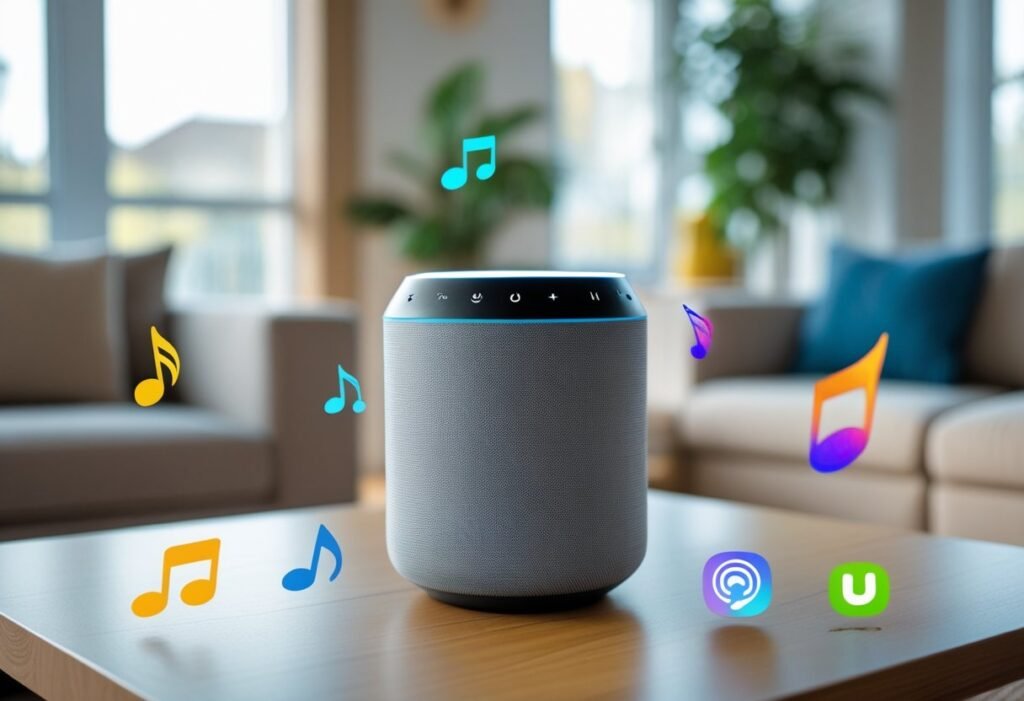
Besides music, the smart speaker can:
- Play audiobooks and podcasts
- Answer trivia questions or tell jokes
- Stream news updates and weather reports
- Control TV and smart devices for movies and shows
| Feature | Description |
|---|---|
| Voice Control | Play music hands-free by speaking commands. |
| Multiple Streaming Services | Access a variety of music and audio platforms. |
| Sound Quality | Clear and rich audio for a better listening experience. |
Whether you want to relax, dance, or learn something new, the smart speaker makes entertainment easy and fun.
Daily Reminders
Managing daily tasks is simpler with Google Assistant. The smart speaker helps you remember important events and activities. You can ask it to set alarms, timers, or reminders using just your voice.
Common uses for daily reminders include:
- Wake-up alarms to start the day on time
- Reminders for appointments or meetings
- Timers for cooking or workouts
- Shopping lists and to-do lists
Here is a simple example of setting a reminder with your voice:
Hey Google, remind me to call mom at 6 PM.The speaker will confirm and notify you at the right time. This helps reduce stress and keeps your day organised.
Using reminders on the smart speaker reduces the risk of forgetting tasks. It works well for all family members, including children and elderly people. The voice commands are easy to use and save you time.
Home Automation
The smart speaker with Google Assistant acts as a hub for home automation. It connects with smart devices around your house. You can control lights, thermostats, security cameras, and more by voice.
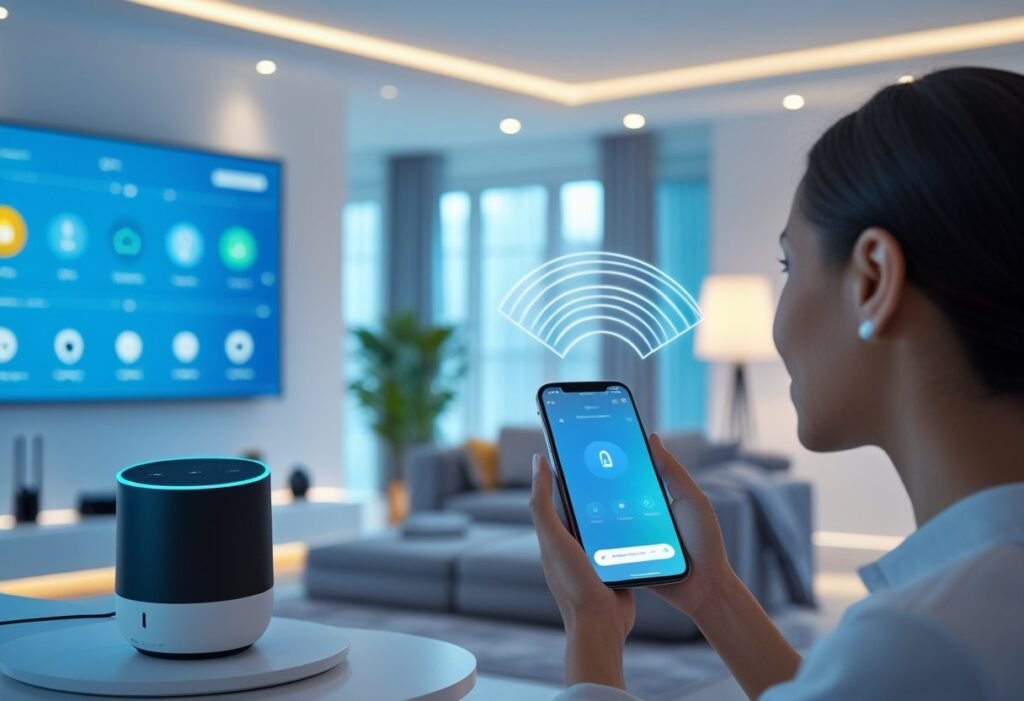
Basic home automation tasks include:
- Turning lights on or off
- Adjusting room temperature
- Locking or unlocking doors
- Checking security cameras
- Starting or stopping smart plugs and appliances
| Device | Example Command |
|---|---|
| Smart Lights | “Hey Google, turn off the living room lights.” |
| Thermostat | “Hey Google, set the temperature to 22 degrees.” |
| Security Camera | “Hey Google, show me the front door camera.” |
Home automation with the smart speaker adds comfort and safety. It reduces the need to move around to control devices. Voice control also helps people with mobility issues manage their homes better.
Privacy And Security
Smart speakers with Google Assistant offer great convenience, but privacy and security are top concerns. These devices listen for your voice commands and process data to respond. Protecting your personal information is essential to keep your smart home safe. Understanding how these devices handle privacy helps you use them with confidence.
Data Protection Measures
Google uses strong security to protect data collected by smart speakers. This includes:
- Encryption: All voice commands and data are encrypted during transmission and storage. This means no one can easily access your information.
- Secure Servers: Data is stored on Google’s secure servers, which have strict security controls and regular audits.
- Access Controls: Only authorised systems and personnel can access your data under strict rules.
- Regular Updates: Google releases frequent software updates to fix security issues and improve protection.
Here is a simple table summarising these measures:
| Security Feature | Purpose |
|---|---|
| Encryption | Protects data in transit and at rest |
| Secure Servers | Stores data safely with strict controls |
| Access Controls | Limits data access to authorized users |
| Regular Updates | Fixes vulnerabilities and enhances security |
These layers of protection help keep your information private and secure from hackers and unauthorised users.
Managing Voice Recordings
Smart speakers save voice recordings to improve responses. You can control and manage these recordings easily. Here are key points about managing voice data:
- Review Recordings: You can listen to stored voice commands in your Google Account.
- Delete Recordings: Remove individual or all voice recordings anytime to protect your privacy.
- Automatic Deletion: Set recordings to delete automatically after 3, 18, or 36 months.
- Pause Recording: Temporarily pause voice data collection to stop saving commands.
Steps to delete voice recordings:
- Go to your Google Account settings.
- Find the “Data & Privacy” section.
- Select “Web & App Activity.”
- Choose “Manage Activity” and delete recordings.
Managing voice recordings gives you control over what Google saves and helps keep your data private.
User Controls
Google Assistant offers many privacy controls. You can customise settings to match your comfort level. Important user controls include:
- Mute Microphone: Physically turn off the microphone to prevent listening.
- Voice Match: Set up voice recognition to restrict access to your personal info.
- Activity Controls: Choose what data Google saves, including voice commands and app activity.
- Guest Mode: Enable guest mode to limit data collection during visitor use.
Here is a quick overview of these controls:
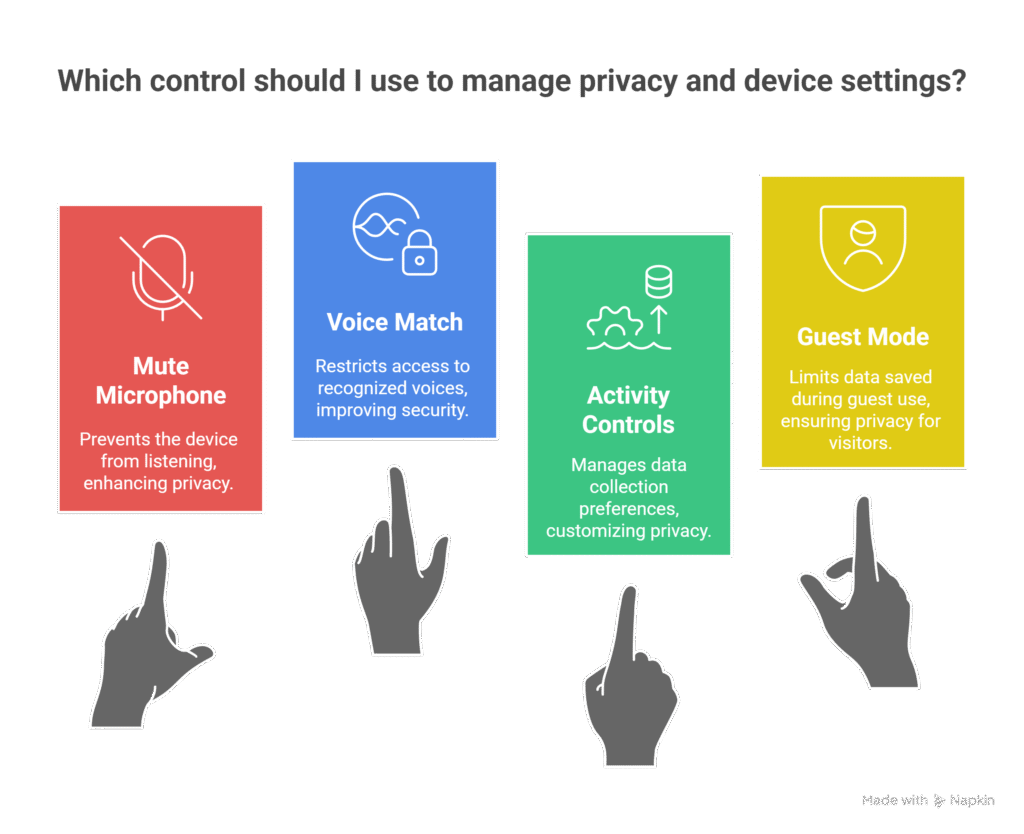
| Control | Function |
|---|---|
| Mute Microphone | Stops the device from listening |
| Voice Match | Restricts access to recognized voices |
| Activity Controls | Manages data collection preferences |
| Guest Mode | Limits data saved during guest use |
Using these controls helps you keep your smart speaker secure and respects your privacy needs.
Troubleshooting Tips
Smart speakers with Google Assistant make daily tasks easier. They play music, answer questions, and control smart home devices. Sometimes, these devices experience issues that prevent them from working properly. Troubleshooting helps fix these problems quickly. Knowing simple steps saves time and keeps your smart speaker running smoothly.
Connectivity Issues
Connectivity problems are common with smart speakers. They need a strong Wi-Fi signal to work correctly. If your device can’t connect, try these tips:
- Check Wi-Fi signal strength. Move the speaker closer to the router.
- Restart your router and speaker. Power off, wait 30 seconds, then turn on.
- Verify Wi-Fi password. Make sure it is correct in the Google Home app.
- Limit devices on your network. Too many devices can slow the connection.
Use this table to track common connectivity fixes:
| Problem | Solution | Expected Result |
|---|---|---|
| Weak Wi-Fi signal | Restart the router and speaker | Improved connection and faster response |
| Incorrect Wi-Fi password | The network is slow or unstable | Speaker connects to the network |
| The network is slow or unstable | Network is slow or unstable | Stable and faster internet access |
Voice Command Problems
Voice-command issues reduce the usefulness of the smart speaker. The device may not hear or understand you well. Try these steps to improve voice recognition:
- Speak clearly and at a moderate volume. Avoid shouting or whispering.
- Reduce background noise. Turn off fans or TVs nearby.
- Check microphone settings. Make sure the mic is not muted.
- Train Google Assistant. Use the app to teach your voice.
Here is a quick checklist for voice command troubleshooting:
- Is the microphone on?
- Are you speaking clearly?
- Is the room quiet?
- Has the assistant learned your voice?
Device Updates
Keeping your smart speaker updated is important. Updates fix bugs and add new features. Sometimes, update problems cause the device to stop working.
Follow these update tips:
- Check for updates regularly. Use the Google Home app to see available updates.
- Keep the speaker plugged in. Updates fail if the device loses power.
- Ensure stable internet during updates. A weak connection can cause errors.
- Restart the device after updates. This helps apply changes correctly.
Use this table to understand update status meanings:
| Status | Meaning | Action |
|---|---|---|
| Update Available | The device is downloading and installing | Restart the device and try again |
| Updating | Start update via the Google Home app | Do not unplug the device |
| Update Failed | Update did not complete | Start updating via the Google Home app |
Frequently Asked Questions
What Is A Smart Speaker With Google Assistant?
A smart speaker with Google Assistant is a voice-controlled device. It uses Google’s AI to answer questions, play music, and control smart home gadgets. It enhances convenience by allowing hands-free tasks through simple voice commands.
How Does Google Assistant Improve Smart Speaker Usability?
Google Assistant enables natural voice interactions with the smart speaker. It understands context, answers queries quickly, and manages tasks efficiently. This AI integration makes the device more intuitive and user-friendly, improving the daily user experience.
Can Smart Speakers With Google Assistant Control Smart Home Devices?
Yes, smart speakers with Google Assistant can control various smart home devices. They connect to lights, thermostats, cameras, and more. Users can manage home settings via voice commands for convenience and automation.
Are Smart Speakers With Google Assistant Compatible With Other Apps?
Smart speakers with Google Assistant support many popular apps. They integrate with music, news, calendar, and streaming services. This compatibility expands their functionality, making them versatile tools for daily use.
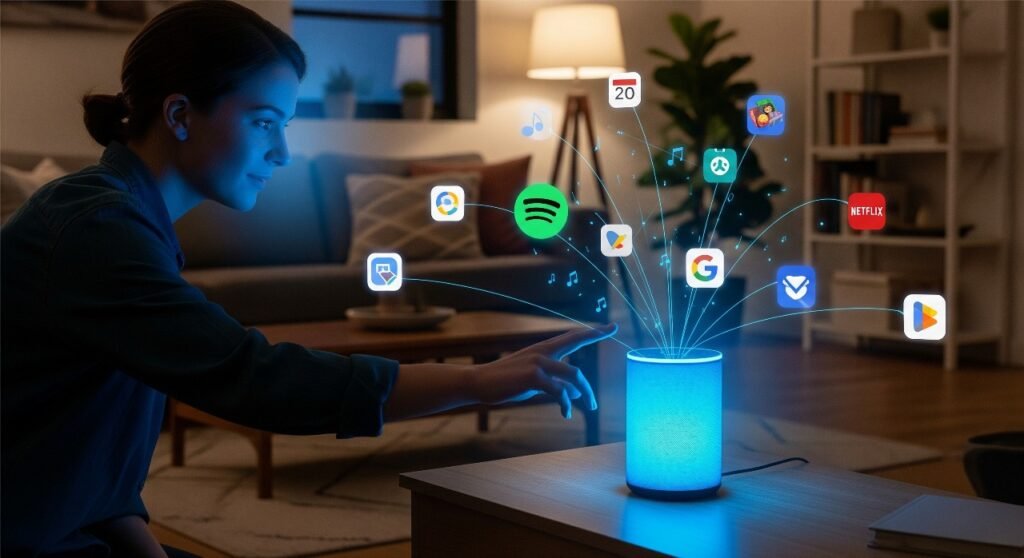
Conclusion
A smart speaker with Google Assistant makes daily tasks easier. It responds to your voice quickly and clearly. You can play music, set reminders, and ask questions. It fits well in any room or lifestyle. Small but helpful, it saves time and effort.
Everyone can enjoy the convenience it brings. Try adding simple tech help at home. A smart speaker listens, learns, and assists quietly. Easy to use and ready to help anytime.



